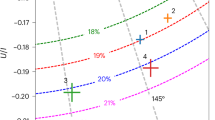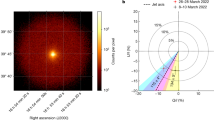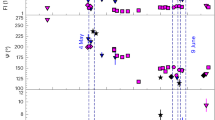Abstract
Pulsar wind nebulae are formed when outflows of relativistic electrons and positrons hit the surrounding supernova remnant or interstellar medium at a shock front. The Vela pulsar wind nebula is powered by a young pulsar (B0833-45, aged 11,000 years)1 and located inside an extended structure called Vela X, which is itself inside the supernova remnant2. Previous X-ray observations revealed two prominent arcs that are bisected by a jet and counter jet3,4. Radio maps have shown high linear polarization of 60% in the outer regions of the nebula5. Here we report an X-ray observation of the inner part of the nebula, where polarization can exceed 60% at the leading edge—approaching the theoretical limit of what can be produced by synchrotron emission. We infer that, in contrast with the case of the supernova remnant, the electrons in the pulsar wind nebula are accelerated with little or no turbulence in a highly uniform magnetic field.
This is a preview of subscription content, access via your institution
Access options
Access Nature and 54 other Nature Portfolio journals
Get Nature+, our best-value online-access subscription
$29.99 / 30 days
cancel any time
Subscribe to this journal
Receive 51 print issues and online access
$199.00 per year
only $3.90 per issue
Buy this article
- Purchase on Springer Link
- Instant access to full article PDF
Prices may be subject to local taxes which are calculated during checkout


Similar content being viewed by others
Data availability
IXPE data are available through the NASA’s HEASARC data archive (https://heasarc.gsfc.nasa.gov). Other derived data supporting the findings of this study are available from the corresponding author on request. Source data are provided with this paper.
Code availability
The High Energy Astrophysics Science Archive Research Center (HEASARC) developed the HEASOFT (HEASARC Software). We used the HEASOFT v.6.30.1 package for the spectropolarimetric IXPE data analysis, which is available online (https://heasarc.gsfc.nasa.gov/docs/software/heasoft/). The proper instrument response functions are provided by the IXPE Team as a part of the IXPE calibration database released on 14 March 2022 are and available in the HEASARC Calibration Database (https://heasarc.gsfc.nasa.gov/docs/heasarc/caldb/caldb_supported_missions.html). The software developed by IXPE collaboration is available publicly online (https://ixpeobssim.readthedocs.io/en/latest/?badge=latest). Information supporting the findings of this study is available from the corresponding author on request.
References
Caraveo, P. A., De Luca, A., Mignani, R. P. & Bignami, G. F. The distance to the Vela Pulsar gauged with Hubble Space Telescope parallax observations. Astrophys. J. 561, 930–937 (2001).
Slane, P. et al. Investigating the structure of Vela X. Astrophys. J. 865, 86 (2018).
Pavlov, G. G., Kargaltsev, O. Y., Sanwal, D. & Garmire, G. P. Variability of the Vela Pulsar wind nebula observed with Chandra. Astrophys. J. Lett. 554, L189–L192 (2001).
Helfand, D. J., Gotthelf, E. V. & Halpern, J. P. Vela Pulsar and its synchrotron nebula. Astrophys. J. 556, 380–391 (2001).
Dodson, R., Lewis, D., McConnell, D. & Deshpande, A. A. The radio nebula surrounding the Vela pulsar. Mon. Not. R. Astron. Soc. 343, 116–124 (2003).
Soffitta, P. et al. The instrument of the Imaging X-ray Polarimetry Explorer. Astron. J. 162, 208 (2021).
Weisskopf, M. C. et al. The Imaging X-ray Polarimetry Explorer (IXPE): pre-launch. J. Astron. Telesc. Instrum. Syst. 8, 026002 (2022).
Costa, E. et al. An efficient photoelectric x-ray polarimeter for the study of black holes and neutron stars. Nature 411, 662–665 (2001).
Baldini, L. et al. Design, construction, and test of the Gas Pixel Detectors for the IXPE mission. Astropart. Phys. 133, 102628 (2021).
Weisskopf, M. C. et al. Measurement of the X-ray polarization of the Crab Nebula. Astrophys. J. Lett. 208, L125–L128 (1976).
Weisskopf, M. C., Silver, E. H., Kestenbaum, H. L., Long, K. S. & Novick, R. A precision measurement of the X-ray polarization of the Crab Nebula without pulsar contamination. Astrophys. J. Lett. 220, L117–L121 (1978).
Feng, H. et al. Re-detection and a possible time variation of soft X-ray polarization from the Crab. Nat. Astron. 4, 511–516 (2020).
Pavlov, G. G., Zavlin, V. E., Sanwal, D., Burwitz, V. & Garmire, G. P. The X-ray spectrum of the Vela Pulsar resolved with the Chandra X-ray observatory. Astrophys. J. Lett. 552, L129–L133 (2001).
Bucciantini, N. et al. Simultaneous space and phase resolved X-ray polarimetry of the Crab Pulsar and Nebula. Preprint at arXiv https://arxiv.org/abs/2207.05573 (2022).
Ng, C. Y. & Romani, R. W. Fitting pulsar wind tori. Astrophys. J. 601, 479–484 (2004).
Lyubarsky, Y. E. On the structure of the inner Crab Nebula. Mon. Not. R. Astron. Soc. 329, L34–L36 (2002).
Komissarov, S. S. & Lyubarsky, Y. E. The origin of peculiar jet-torus structure in the Crab nebula. Mon. Not. R. Astron. Soc. 344, L93–L96 (2003).
Del Zanna, L., Amato, E. & Bucciantini, N. Axially symmetric relativistic MHD simulations of pulsar wind nebulae in supernova remnants. On the origin of torus and jet-like features. Astron. Astrophys. 421, 1063–1073 (2004).
Komissarov, S. S. & Lyubarsky, Y. E. Synchrotron nebulae created by anisotropic magnetized pulsar winds. Mon. Not. R. Astron. Soc. 349, 779–792 (2004).
Bucciantini, N., del Zanna, L., Amato, E. & Volpi, D. Polarization in the inner region of pulsar wind nebulae. Astron. Astrophys. 443, 519–524 (2005).
Del Zanna, L., Volpi, D., Amato, E. & Bucciantini, N. Simulated synchrotron emission from pulsar wind nebulae. Astron. Astrophys. 453, 621–633 (2006).
Rybicki, G. B. & Lightman, A. P. Radiative Processes in Astrophysics (Wiley, 1986).
Kargaltsev, O., Pavlov, G. G., Sanwal, D. & Garmire, G. P. in Neutron Stars in Supernova Remnants Vol. 271 (eds Slane, P. O. & Gaensler, B. M.) 181 (Astronomical Society of the Pacific, 2002).
Sironi, L., Keshet, U. & Lemoine, M. Relativistic shocks: particle acceleration and magnetization. Space Sci. Rev. 191, 519–544 (2015).
Sironi, L. & Spitkovsky, A. Relativistic reconnection: an efficient source of non-thermal particles. Astrophys. J. Lett. 783, L21 (2014).
Bock, D. C. J., Sault, R. J., Milne, D. K. & Green, A. J. in Neutron Stars in Supernova Remnants Vol. 271 (eds Slane, P. O. & Gaensler, B. M.) 187 (Astronomical Society of the Pacific, 2002).
Moran, P., Mignani, R. P. & Shearer, A. HST optical polarimetry of the Vela pulsar and nebula. Mon. Not. R. Astron. Soc. 445, 835–844 (2014).
Kislat, F., Clark, B., Beilicke, M. & Krawczynski, H. Analyzing the data from X-ray polarimeters with Stokes parameters. Astropart. Phys. 68, 45–51 (2015).
Rankin, J. et al. An algorithm to calibrate and correct the response to unpolarized radiation of the X-ray polarimeter onboard IXPE. Astron. J. 163, 39 (2022).
Joye, W. A. in Astronomical Data Analysis Software and Systems XV Vol. 351 (eds Gabriel, C., Arviset, C., Ponz, D. & Enrique, S.) 574 (Astronomical Society of the Pacific, 2006).
Di Marco, A. et al. A weighted analysis to improve the X-ray polarization sensitivity of the imaging X-ray Polarimetry Explorer. Astron. J. 163, 170 (2022).
Baldini, L. et al. ixpeobssim: A simulation and analysis framework for the imaging X-ray polarimetry explorer. SoftwareX 19, 101194 (2022).
Strohmayer, T. E. X-ray spectro-polarimetry with photoelectric polarimeters. Astrophys. J. 838, 72 (2017).
Arnaud, K. A. in Astronomical Data Analysis Software and Systems V Vol. 101 (eds Jacoby, G. H. & Barnes, J.) 17 (Astronomical Society of the Pacific, 1996).
Acknowledgements
The IXPE is a joint US and Italian mission. The US contribution is supported by the National Aeronautics and Space Administration (NASA) and is led and managed by the Marshall Space Flight Center (MSFC), with industry partner Ball Aerospace (contract NNM15AA18C). The Italian contribution is supported by the Italian Space Agency (Agenzia Spaziale Italiana, ASI) through contract ASI-OHBI-2017-12-I.0, agreements ASI-INAF-2017-12-H0 and ASI-INFN-2017.13-H0, and its Space Science Data Center (SSDC) with agreements ASI-INAF-2022-14-HH.0 and ASI-INFN 2021-43-HH.0, and by the Istituto Nazionale di Astrofisica (INAF) and the Istituto Nazionale di Fisica Nucleare (INFN) in Italy. This research used data products provided by the IXPE Team (MSFC, SSDC, INAF and INFN) that are distributed with additional software tools by the High-Energy Astrophysics Science Archive Research Center (HEASARC), at NASA Goddard Space Flight Center (GSFC). The research at Guangxi University was supported in part by National Natural Science Foundation of China (grant no. 12133003). The research at Boston University was supported in part by National Science Foundation grant AST-2108622. I.A. acknowledges financial support from the Spanish ‘Ministerio de Ciencia e Innovación’ (MCINN) through the ‘Center of Excellence Severo Ochoa’ award for the Instituto de Astrofísica de Andalucía-CSIC (SEV-2017-0709) and through grants AYA2016-80889-P and PID2019-107847RB-C44.
Author information
Authors and Affiliations
Contributions
F.X. led the data analysis and the writing of the paper. A.D.M. and F.L.M. performed the spectropolarimetric analysis and contributed to the paper. F. Muleri and J.R. contributed to the data analysis and energy calibration of the dataset. K.L. and N.B. contributed to the data analysis and result interpretation. R.W.R. and L.L. helped to revise the manuscript. E. Costa, P. Soffitta, M.B., S.F., R.F., M. Pilia and A.T. contributed to the interpretation of the results and to text revisions. N.D.L., S.G., N.O., M.N. and E.W. performed independent analysis of the data. The other authors contributed to the design of the mission, to the calibration of the instrument, to the definition of its scientific case and to the planning of the observations. All of the authors provided inputs and comments on the manuscript.
Corresponding author
Ethics declarations
Competing interests
The authors declare no competing interests.
Peer review
Peer review information
Nature thanks the anonymous reviewers for their contribution to the peer review of this work.
Additional information
Publisher’s note Springer Nature remains neutral with regard to jurisdictional claims in published maps and institutional affiliations.
Extended data figures and tables
Extended Data Fig. 1 Light curve of the Vela PWN observed by IXPE DU1 before and after data filtering (top and bottom panels, respectively).
Filtering the high count-rate excursions from the event_l2 file removes approximately 1.47% of the exposure time.
Extended Data Fig. 2 Total nebula source (white 1′ radius circle) and background (blue annulus, inner radius 2′, outer radius 4.7′) regions shown on images from DU1 (left) to DU3 (right).
Intensity is on a logarithmic scale to bring out the faint background.
Extended Data Fig. 3 Spectral joint fitting for the Stokes parameters in the 2–8 keV energy band for the three DUs using model TBABS*POWERLAW*POLCONST with previously fit spectral parameters fixed.
The average background count I spectrum for the three DUs is shown in black. Fit residuals are shown at the bottom.
Extended Data Fig. 4 Polar plot showing the polarization degree (PD) and polarization angle (PA) fit with data from the three DUs, for different energy bands.
Ellipses show the 68.3% confidence level errors obtained with XSPEC.
Extended Data Fig. 5
An alternative spatial partition of the PWN with regions aligned with the PWN symmetry axis on image observed by Chandra. L, R, F, B label the left, right, front, back regions with respect to the C centre region respectively, corresponding to the analysis tabulated in Extended Data Table 4. The inner circle has a radius of 15′′ and the outer circle radius is 45′′.
Extended Data Fig. 6 Q/I (top) and U/I (bottom) Stokes parameters of the Vela PWN as functions of energy in 2–8 keV range derived with ixpeobssim and XSPEC independently.
The results are from the joint analysis of three DUs.
Source data
Rights and permissions
Springer Nature or its licensor (e.g. a society or other partner) holds exclusive rights to this article under a publishing agreement with the author(s) or other rightsholder(s); author self-archiving of the accepted manuscript version of this article is solely governed by the terms of such publishing agreement and applicable law.
About this article
Cite this article
Xie, F., Di Marco, A., La Monaca, F. et al. Vela pulsar wind nebula X-rays are polarized to near the synchrotron limit. Nature 612, 658–660 (2022). https://doi.org/10.1038/s41586-022-05476-5
Received:
Accepted:
Published:
Issue Date:
DOI: https://doi.org/10.1038/s41586-022-05476-5
This article is cited by
-
Revealing the magnetic field geometry in the Milky Way’s most efficient particle accelerator
Nature Astronomy (2023)
-
Variably polarized X-ray sources for LPD calibration
Experimental Astronomy (2023)
-
Establishment and study of a polarized X-ray radiation facility
Nuclear Science and Techniques (2023)
-
X-rays reveal the magnetic field lighting up a stellar graveyard
Nature (2022)
Comments
By submitting a comment you agree to abide by our Terms and Community Guidelines. If you find something abusive or that does not comply with our terms or guidelines please flag it as inappropriate.



